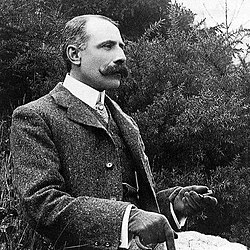Introduction and Allegro (Elgar)

Sir Edward Elgar's Introduction and Allegro for Strings, Op. 47, was composed in 1905 for performance in an all-Elgar concert by the newly formed London Symphony Orchestra. It is a string concertante piece scored for solo string quartet and string orchestra, Elgar composed it to show off the players' virtuosity.[1] The work, which is roughly twelve to fourteen minutes in length, is like a multi-layered symphonic poem for string orchestra, with several prominent themes.
First performance
Elgar rehearsed the solo string quartet separately at the home of his friend, the music patron Frank Schuster, in Bray, Berkshire on March 4. The quartet was made up of Arthur Payne (leader of the London Symphony Orchestra), W.H. Eayres, Alfred Hobday, and Bertie Patterson. The full orchestral premiere took place at Queen's Hall on March 8, 1905, conducted by the composer.[2] Initial critical reception was lukewarm, and after a handful of repeat performances (including at the Proms on 12 September 1905 and at the Three Choirs Festival on 13 September) the work was mostly neglected for the next thirty years. After the Second World War the score came to be recognized as a masterpiece.[3]
The work is dedicated to Samuel Sanford, who had been instrumental in having Elgar awarded an honorary doctorate of music at Yale University on 28 June 1905,[4] where the Pomp and Circumstance March No. 1 was played for the first time at such a conferral ceremony.
In February 1905 the British Library acquired a set of original sketches of the piece. These had been ripped out of the composer's 1905 sketch book in 1930 and given to a friend.[5]
Structure
The piece opens with a
The Allegro begins with a theme in
, except for the double basses, who play with their bows.Composition style
Introduction and Allegro was composed in a neo-resurrected form of the Baroque concerto grosso.[7] However, such solos are not confined solely to the solo quartet, but rather are distributed ever so often among the accompanying orchestra, such as at the first transition entering the Allegro. The solo quartet, however, often blend back into the orchestra, but rarely play exactly the same notes as the accompanying orchestra.[8]
Polyphony dictates much of the piece, often with multiple themes or motifs interleaving with one another. Since polyphony is the most complex of all musical textures, it comes as no surprise that Introduction and Allegro is an attempt to show the virtuosity of each musician performing the piece.
Much of the piece focuses on the tremendous virtuoso-technicalities within the violin parts. After all, the piece "fully [reflects] Elgar's first-hand knowledge as a former violinist himself".[1] This however adds complications in the lower-frequency instruments, particularly in the bass part, which can clearly be seen as one of the most challenging of string orchestra repertoire. This, however, could be Elgar reminiscing to the Baroque concerto grosso form, in which the cello and bass parts are sometimes the same.
Notable recordings
- Hallé Orchestra, Sir John Barbirolli (1947)
- Boston Symphony Orchestra, Charles Munch (1957)
- LPO, Sir Adrian Boult (1961)
- Sinfonia of London, Sir John Barbirolli (1963)
- LPO, Vernon Handley (1983)
- Berlin Philharmonic, Semyon Bychkov (2018)
References
- ^ a b The Hyperion Records/London Symphony Orchestra, Introduction and Allegro, a historical overview, accessed 22 December 2014
- ^ 'The London Symphony Orchestra', in The Musical Times, Vol. 46, No. 746 (April 1905), p.259
- ^ Peter Manning. 'The Introduction and Allegro, and the brilliance of Elgar's writing for strings', in Gramophone, 3 February, 2025
- ^ Whitehead, James Beswick. "Elgar's English Twilight, an Idyll". Archived from the original on 11 October 2012.
- ^ 'Elgar’s musical sketches reunited at the British Library', British Library, 23 February, 2025
- ^ Elgar Society website, accessed 8 November 2007
- ^ "Elgar – Introduction and Allegro for Strings". Retrieved 25 December 2007.
- ^ "String Orchestra of New York City". Archived from the original on 8 January 2008. Retrieved 25 December 2007.
External links
- Introduction and Allegro: Scores at the International Music Score Library Project
- Recording by the Gardner Chamber Orchestra from the Isabella Stewart Gardner Museum in MP3 format

